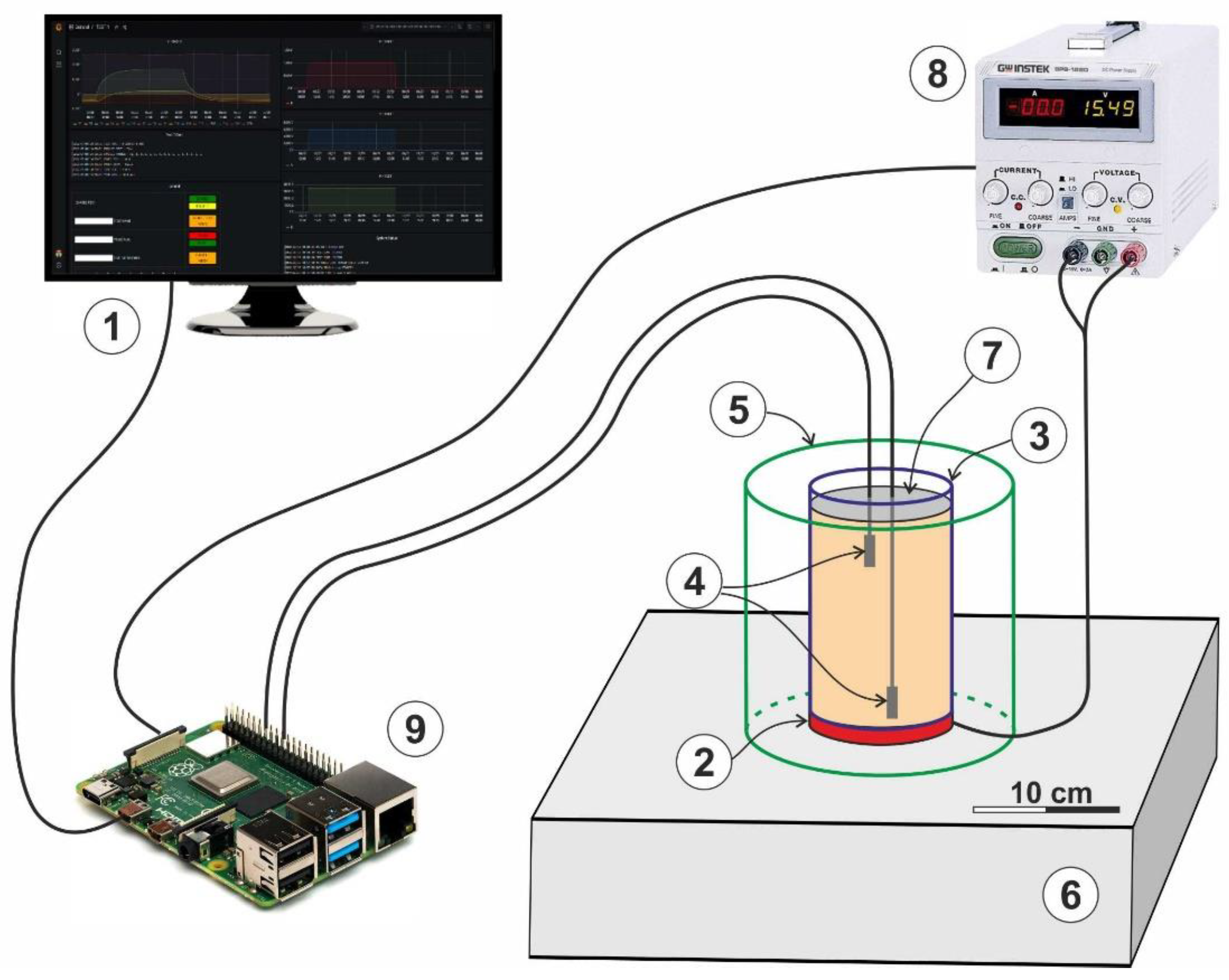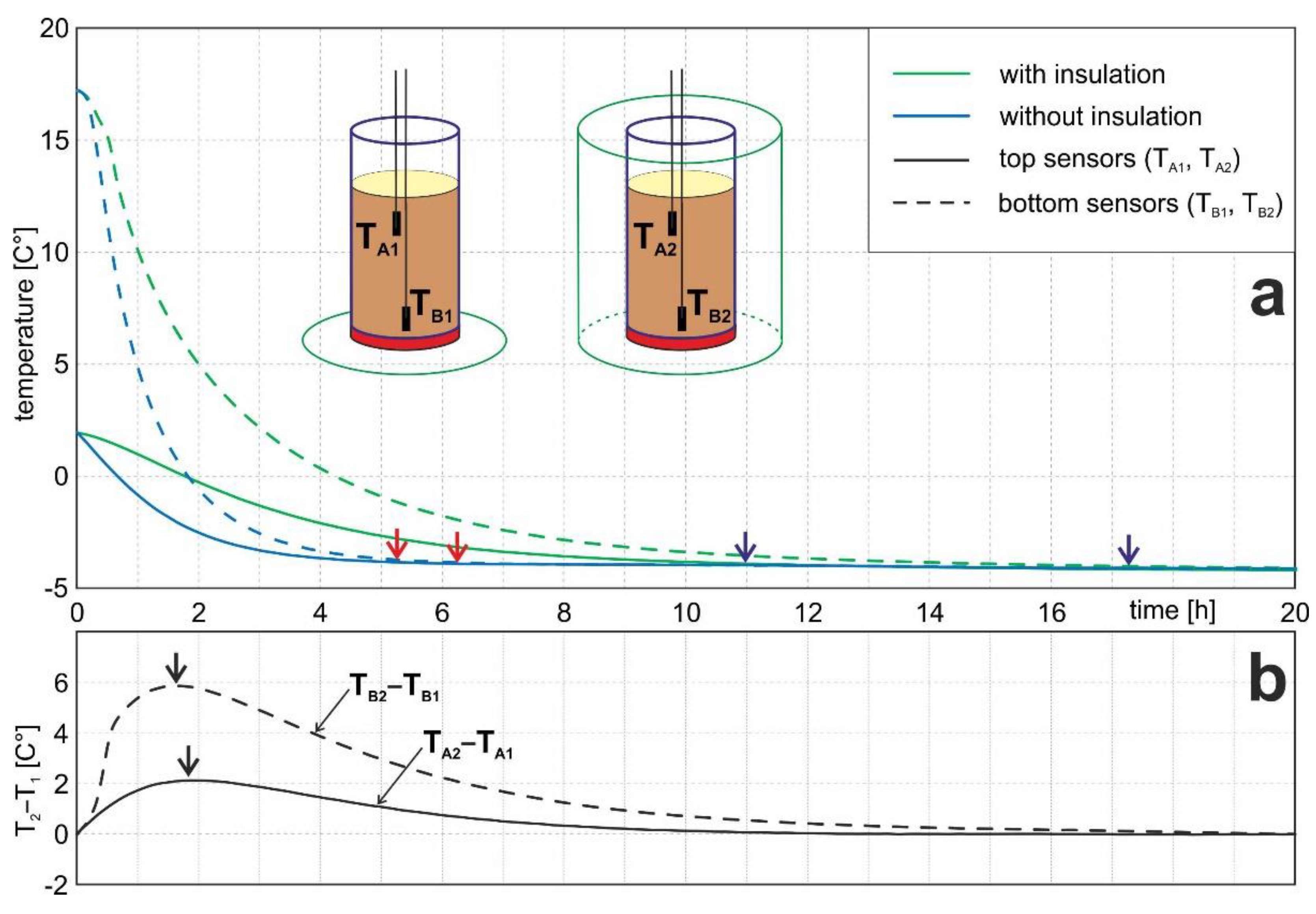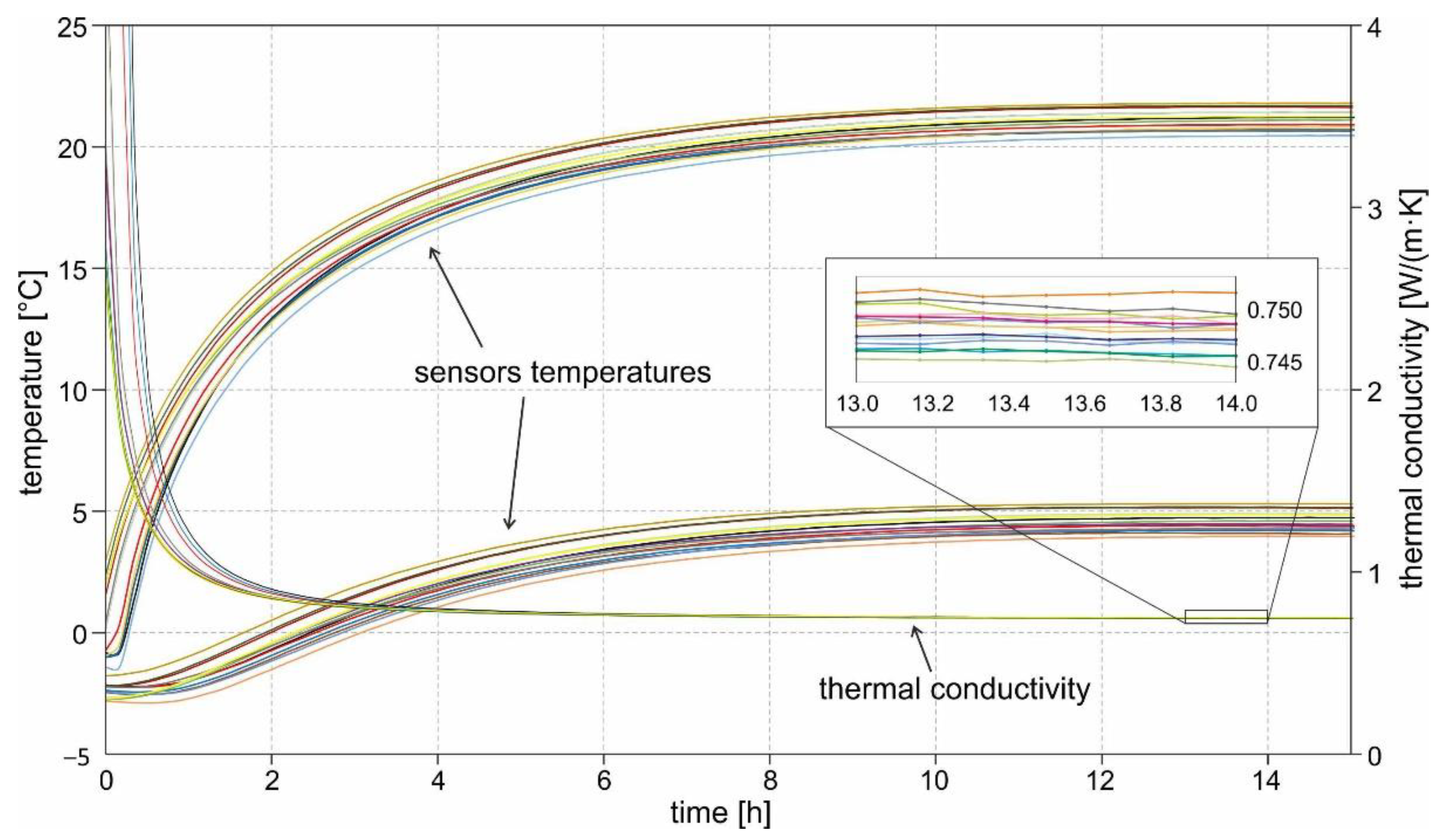GeoTh: An Experimental Laboratory Set-Up for the Measurement of the Thermal Conductivity of Granular Materials
Abstract
1. Introduction
1.1. Heat Transmission Principles
1.2. Other Measurement Approaches
2. Materials and Methods
2.1. Custom-Built Experimental Laboratory Set-Up
2.2. Sample Casing
2.3. Hardware Components
2.4. Software and User Interface
- Raspberry PI System Monitor section contains diagnostics of the single board computer, e.g., CPU temperature and usage, RAM usage and disk usage. This information allows users to investigate possible system failure.
- Daq Log database section contains all runtime information about operations executed by Master Script. This information allows users to check test configuration, correctness of hardware and database accesses, and view history of test operations.
- Temperature section contains all sixteen temperatures measured with a default time sampling interval of about twenty seconds.
- Tests Configuration section contains all details of test configuration, e.g., test name, enabling test, enabled temperature probes, heating power, enabling power, single measurements time sampling, and time interval for recording temperature average for raw data file.
- Tests Data section contains related enabled temperatures and power measurements details.
- Run State section contains information on changes of test configuration and Raspberry shutdown request. Changes on test configuration by user interface are recorded on a single flag in this section and this will trigger Master Script to reconfigure the test with the new set-up.
- Main controller process checks running status of all other five processes, sends infos to Daq Log database section and provides a restart of Main Script in case of failure;
- Daq process is dedicated to temperature measurements and control of the heating power system through the power supply. If at least one of the two possible tests is enabled, all sixteen temperatures and the two channels power supply parameters are acquired at a defined sampling rate and stored in the Temperature section of the database; temperatures are acquired by daughter-cards with SPI protocol with a multiplexed technique driven by GPIO of Raspberry PI; monitor and control of power supply are provided with standard SCPI protocol via USB interface.
- DataProcessing process provides a data remap to related tests and fills the corresponding Tests Data database section.
- DataMean process provides average measurements on a user defined time interval and produces raw data text files.
- CheckConf process checks changes in configuration requested by users, then provides a reconfiguration of tests when required.
- CheckPowerSupply process checks the correctness of connection with the power supply for the heating system.
3. Tests for the Reliability of the Results
3.1. Effect of Ambient Temperature
3.2. Lateral Insulation Tests
3.3. Reproducibility Test
3.4. Comparison with Literature Data
4. Concluding Remarks
Supplementary Materials
Author Contributions
Funding
Institutional Review Board Statement
Informed Consent Statement
Data Availability Statement
Acknowledgments
Conflicts of Interest
References
- Abu-Hamdeh, N.H.; Reeder, R.C. Soil thermal conductivity: Effects of density, moisture, salt concentration, and organic matter. Soil Sci. Soc. Am. J. 2000, 64, 1285–1290. [Google Scholar] [CrossRef]
- Davidson, E.A.; Belk, E.; Boone, R.D. Soil water content and temperature as independent or confounded factors controlling soil respiration in a temperate mixed hardwood forest. Glob. Chang. Biol. 1998, 4, 217–227. [Google Scholar] [CrossRef]
- Curiel Yuste, J.; Baldocchi, D.D.; Gershenson, A.; Goldstein, A.; Misson, L.; Wong, S. Microbial soil respiration and its dependency on carbon inputs, soil temperature and moisture. Glob. Chang. Biol. 2007, 13, 2018–2035. [Google Scholar] [CrossRef]
- Almagro, M.; Lopez, J.; Querejeta, M.; Martìnez-Mena, M. Temperature dependence of soil CO2 efflux is strongly modulated by seasonal patterns of moisture availability in a Mediterranean ecosystem. Soil Biol. Biochem. 2009, 41, 594–605. [Google Scholar] [CrossRef]
- Zhang, X.; Xu, H.; Chen, G. Major factors controlling nitrous oxide emission and methane uptake from forest soil. J. Forestry Res. 2001, 12, 239–242. [Google Scholar] [CrossRef]
- Hopmans, J.W.; Simunek, J.; Bristow, K.L. Indirect estimation of soil thermal properties and water flux using heat pulse probe measurements: Geometry and dispersion effects. Water Resour. Res. 2002, 38, 1006. [Google Scholar] [CrossRef]
- Nkongolo, N.V.; Johnson, S.; Schmidt, K.; Eivazi, F. Greenhouse gases fluxes and soil thermal properties in a pasture in central Missouri. J. Environ. Sci. 2010, 22, 1029–1039. [Google Scholar] [CrossRef] [PubMed]
- Zhao, H.; Zeng, Y.; Lv, S.; Su, Z. Analysis of soil hydraulic and thermal properties for land surface modelling over the Tibetan Plateau. Earth Syst. Sci. Data 2018, 10, 1031–1061. [Google Scholar] [CrossRef]
- Guo, C.; Zhang, L.; Li, S.; Li, Q.; Dai, G. Comparison of soil greenhouse gas fluxes during the spring freeze–thaw period and the growing season in a temperate Broadleaved Korean Pine Forest, Changbai Mountains, China. Forests 2020, 11, 1135. [Google Scholar] [CrossRef]
- Brigaud, F.; Vasseur, G. Mineralogy, porosity and fluid control on thermal conductivity of sedimentary rocks. Geophys. J. Int. 1989, 98, 525–542. [Google Scholar] [CrossRef]
- Lu, S.; Ren, T.; Gong, Y.; Horton, R. An improved model for predicting soil thermal conductivity from water content at room temperature. Soil Sci. Soc. Am. J. 2007, 71, 8–14. [Google Scholar] [CrossRef]
- Cortes, D.D.; Martin, A.I.; Yun, T.S.; Francisca, F.M.; Santamarina, J.C.; Ruppel, C. Thermal conductivity of hydrate-bearing sediments. J. Geophys. Res. 2009, 114, B11103. [Google Scholar] [CrossRef]
- Tarnawski, V.R.; Momose, T.; Leong, W.H. Thermal conductivity of standard sands II. Saturated conditions. Int. J. Thermophys. 2011, 32, 984–1005. [Google Scholar] [CrossRef]
- Market, A.; Bohne, K.; Facklam, M.; Wessolek, G. Pedotransfer functions of soil thermal conductivity for the textural classes sand, silt, and loam. Soil Phys. Hydrol. 2017, 81, 1315–1327. [Google Scholar] [CrossRef]
- Missimer, T.M.; Lopez, O.M. Laboratory measurement of total porosity in unconsolidated quartz sand by two integrated methods. J. Geol. Geophys. 2018, 7, 1000448. [Google Scholar] [CrossRef]
- Carslaw, H.S.; Jaeger, J.C. Conduction of Heat in Solids; Oxford University Press: Oxford, UK, 1959. [Google Scholar]
- Kersten, M.S. Thermal properties of soils. Bull. Univ. Minn. 1949, LII, 1–227. [Google Scholar]
- Farouki, O.T. Thermal Properties of Soils, 5th ed.; CRREL Monograph 81-1; United States Army Corps of Engineers: Hanover, NH, USA, 1981; pp. 91–101.
- Abu-Hamdeh, N.H. Thermal properties of soils as affected by density and water content. Biosyst. Eng. 2003, 86, 97–102. [Google Scholar] [CrossRef]
- Haigh, S.K. Thermal conductivity of sands. Géotechnique 2012, 62, 617–625. [Google Scholar] [CrossRef]
- Lai, Y.; Pei, W.; Zhang, M. Study on theory model of hydro-thermal–me-chanical interaction process in saturated freezing silty soil. Int. J. Heat Mass Transf. 2014, 78, 805–819. [Google Scholar] [CrossRef]
- Di Sipio, E.; Bertermann, D. Thermal properties variations in unconsolidated material for very shallow geothermal application (ITER project). Int. Agrophys. 2018, 32, 149–164. [Google Scholar] [CrossRef]
- Zhang, T.; Cai, G.; Liu, S.; Puppala, A.J. Investigation on thermal characteristics and prediction models of soils. Int. J. Heat Mass Transf. 2019, 106, 1074–1086. [Google Scholar] [CrossRef]
- Johansen, O. Thermal Conductivity of Soils. Ph.D. Thesis, University of Trondheim, Trondheim, Norway, 1975. (English Translation 637, US Army Corps of Engineers, Cold Regions Research and Engineering Laboratory, Hanover, New Hampshire ed.). [Google Scholar]
- Côté, J.; Konrad, J.M. A generalized thermal conductivity model for soils and construction materials. Can. Geotech. J. 2005, 42, 443–458. [Google Scholar] [CrossRef]
- Chen, S.X. Thermal conductivity of sands. Heat Mass Transfer 2008, 44, 1241–1246. [Google Scholar] [CrossRef]
- Weidenfeld, G.; Weiss, Y.; Kalman, H. A theoretical model for effective thermal conductivity (ETC) of particulate beds under compression. Granular Matter 2004, 6, 121–129. [Google Scholar] [CrossRef]
- Garret, D.; Ban, H. Compressive pressure dependent anisotropic effective thermal conductivity of granular beds. Granular Matter 2011, 13, 685–696. [Google Scholar] [CrossRef]
- Yun, T.S.; Santamarina, J.C. Fundamental study of thermal conduction in dry soils. Granular Matter 2008, 10, 197–207. [Google Scholar] [CrossRef]
- Ingersoll, L.R.; Zobel, O.J.; Ingersoll, A.C. Heat Conduction with Engineering, Geological, and Other Applications; Oxford & IBH Publish. Co.: New Delhi, India, 1954; p. 355. [Google Scholar]
- Wagner, V.; Bayer, P.; Bisch, G.; Kubert, M.; Blum, P. Hydraulic characterization of aquifers by thermal response testing: Validation by large-scale tank and field experiments. Water Resour. Res. 2014, 50, 71–85. [Google Scholar] [CrossRef]
- Beier, R.A.; Smith, M.D.; Spitler, J.D. Reference data sets for vertical borehole ground heat exchanger models and thermal response test analysis. Geothermics 2011, 40, 79–85. [Google Scholar] [CrossRef]
- Kramer, C.A.; Ghasemi-Fare, O.; Basu, P. Laboratory thermal performance tests on a model heat exchanger pile in sand. Geotech. Geol. Eng. 2014, 33, 253–271. [Google Scholar] [CrossRef]
- Giordano, N.; Bima, E.; Caviglia, C.; Comina, C.; Mandrone, G.; Passarella, M. Modellazione analogica e numerica di un flusso termico in un mezzo poroso in laboratorio attraverso scatola termica. Geoing. Ambient. Min. 2013, 50, 23–32. [Google Scholar]
- Dalla Santa, G.; Peron, F.; Galgaro, A.; Cultrera, M.; Bertermann, D.; Mueller, J.; Bernardi, A. Laboratory measurements of gravel thermal Conductivity: An updated methodological approach. Energy Procedia 2017, 125, 671–677. [Google Scholar] [CrossRef]
- Katsura, T.; Nagano, K.; Takeda, S.; Shimakura, K. Heat transfer experiment in the ground with ground water advection. In Proceedings of the 10th Energy Conservation Thermal Energy Storage Conf., Galloway, NJ, USA, 2 June 2006. [Google Scholar]
- Daw, J.; Rempe, J.; Condie, K.; Knudson, D.; Wilkins, S.C.; Fox, B.S.; Ban, H. Hot Wire Needle Probe for in-Pile Thermal Conductivity Detection; Idaho National Laboratory: Idaho Falls, ID, USA, 2010; INL/CON-10-19633. [Google Scholar]
- Di Sipio, E.; Bertermann, D. Influence of different moisture and load conditions on heat transfer within soils in very shallow geothermal application: An overview of ITER Project. In Proceedings of the 42nd Workshop on Geothermal Reservoir Engineering, Stanford, CA, USA, 13–15 February 2017. [Google Scholar]
- Roshankhah, S.; Garcia, A.V.; Santamarina, J.C. Thermal conductivity of sand–silt mixtures. J. Geotech. Geoenviron. Eng. 2020, 147, 06020031. [Google Scholar] [CrossRef]
- VDI 4640. Thermal Use of the Underground, Fundamentals, Approvals, Environmental Aspects; Verlag des Vereins Deutscher Ingenieur: Düsseldorf, Germany, 2010. [Google Scholar]
- Abu-Hamdeh, N.H.; Khdair, A.I.; Reeder, R.C. A comparison of two methods used to evaluate thermal conductivity for some soils. Int. J. Heat Mass Transf. 2001, 44, 1073–1078. [Google Scholar] [CrossRef]
- Nusier, O.K.; Abu-Hamdeh, N.H. Laboratory techniques to evaluate thermal conductivity for some soils. Heat Mass Transf. 2000, 39, 119–123. [Google Scholar] [CrossRef]
- Barry Macaulay, B.; Bouazza, A.; Sing, R.M.; Wang, B.; Ranjith, P.G. Thermal conductivity of soils and rocks from the Melbourne (Australia) region. Eng. Geol. 2013, 164, 131–138. [Google Scholar] [CrossRef]
- Hamdhan, I.N.; Clarke, B.G. Determination of thermal conductivity of coarse and fine sand soils. In Proceedings of the World Geothermal Congress, Bali, Indonesia, 25–29 April 2010; pp. 1–7. [Google Scholar]









| Strengths | Weaknesses | Opportunities | Threats |
|---|---|---|---|
|
|
|
|
Publisher’s Note: MDPI stays neutral with regard to jurisdictional claims in published maps and institutional affiliations. |
© 2022 by the authors. Licensee MDPI, Basel, Switzerland. This article is an open access article distributed under the terms and conditions of the Creative Commons Attribution (CC BY) license (https://creativecommons.org/licenses/by/4.0/).
Share and Cite
Rapti, D.; Marchetti, A.; Andreotti, M.; Neri, I.; Caputo, R. GeoTh: An Experimental Laboratory Set-Up for the Measurement of the Thermal Conductivity of Granular Materials. Soil Syst. 2022, 6, 88. https://doi.org/10.3390/soilsystems6040088
Rapti D, Marchetti A, Andreotti M, Neri I, Caputo R. GeoTh: An Experimental Laboratory Set-Up for the Measurement of the Thermal Conductivity of Granular Materials. Soil Systems. 2022; 6(4):88. https://doi.org/10.3390/soilsystems6040088
Chicago/Turabian StyleRapti, Dimitra, Andrea Marchetti, Mirco Andreotti, Ilaria Neri, and Riccardo Caputo. 2022. "GeoTh: An Experimental Laboratory Set-Up for the Measurement of the Thermal Conductivity of Granular Materials" Soil Systems 6, no. 4: 88. https://doi.org/10.3390/soilsystems6040088
APA StyleRapti, D., Marchetti, A., Andreotti, M., Neri, I., & Caputo, R. (2022). GeoTh: An Experimental Laboratory Set-Up for the Measurement of the Thermal Conductivity of Granular Materials. Soil Systems, 6(4), 88. https://doi.org/10.3390/soilsystems6040088







